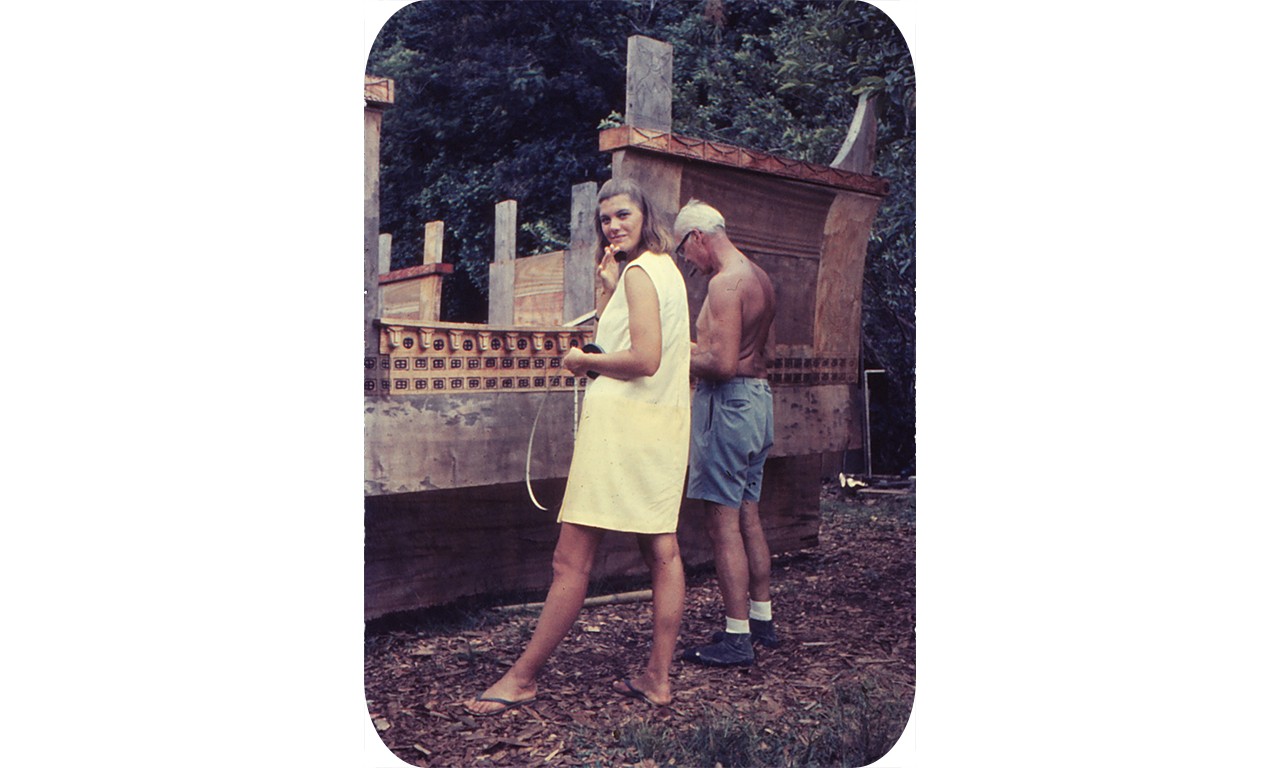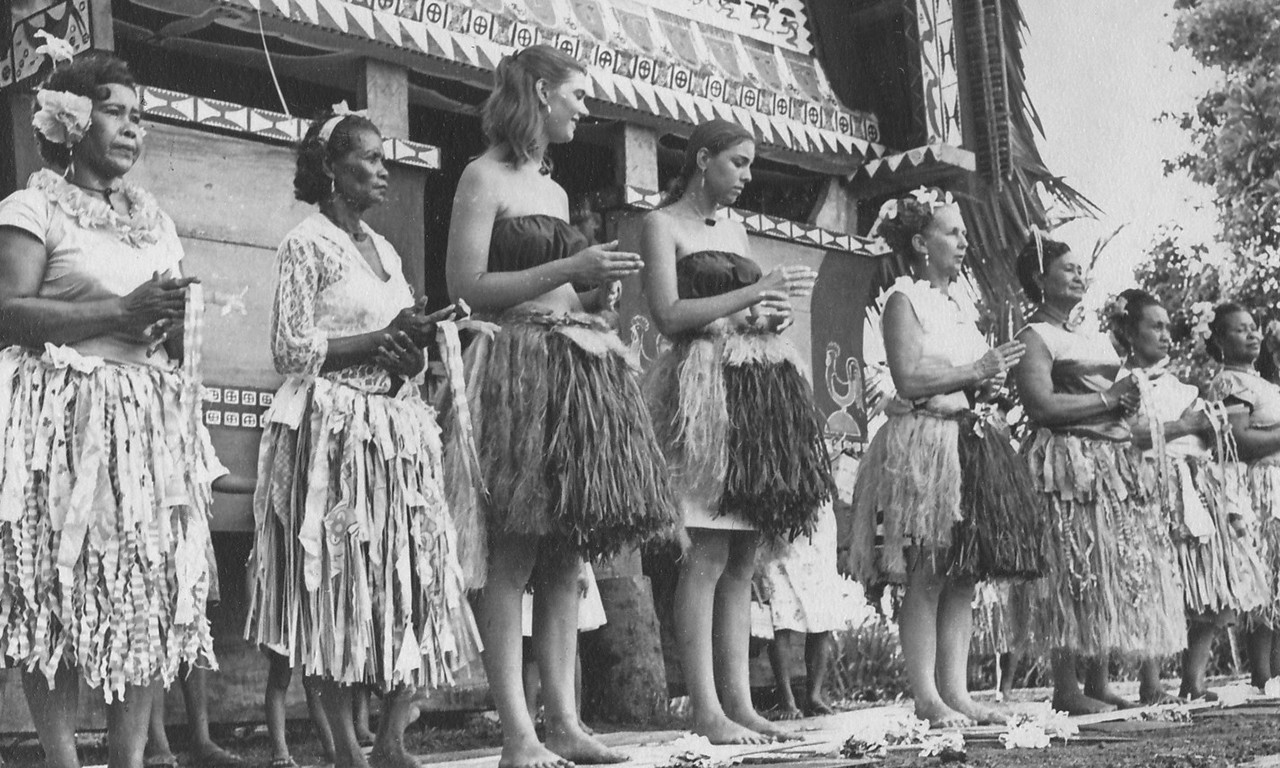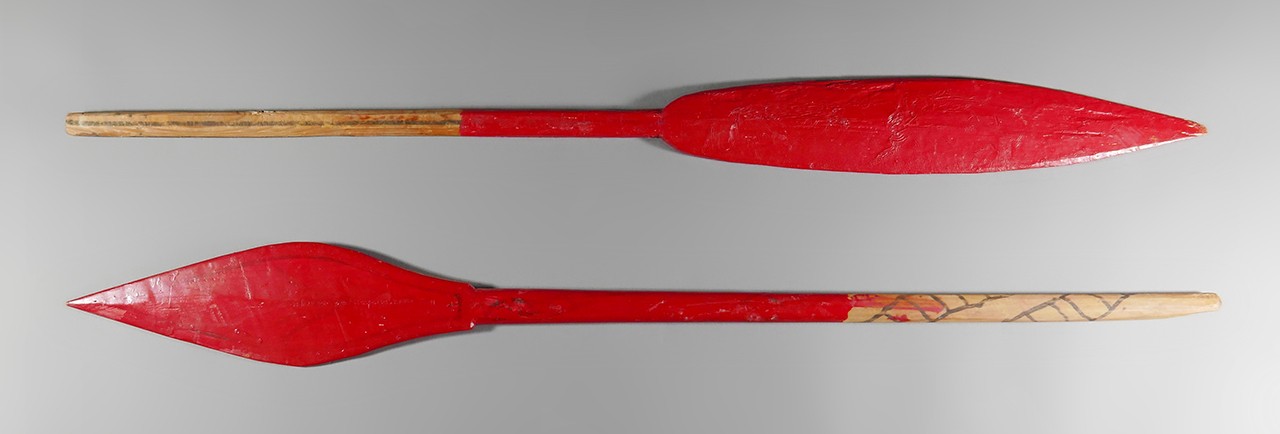The Osborne Collection: Opening Ceremony Pt. 1
 |
| The Bai ra Ngesechel ar Cherchar shortly after being constructed Image courtesy of Frieda Wray |
Grand Opening
Openings are extravagant affairs. If all goes to plan they only happen once, so to commemorate the moment there should be a grand party with musicians, speakers thanking all those involved and, most importantly, there should be a pair of comically oversized scissors used for a ribbon cutting. Some details of this generalization may differ from culture to culture with a handful shockingly not using novelty scissors at all. In last week’s Bowers Blog series on the Osborne Family we introduced the Palau Museum’s Bai ra Nagsechel ar Cherchar and talked about the Osborne’s involvement in the building’s construction between 1968 and ‘69. The next two posts in this series focus on the traditional ceremonies marking the opening of the bai, and the participation of Carolyn Osborne and her two daughters, Frieda and Ellen, in the inaugural performance.
 |
| Frieda and Douglas Osborne working on measurements for the bai, 1968-1969 Image courtesy of Frieda Wray |
Don’t Let Gone Bai be Bygones
To begin, it is important to reiterate a little about the function of bai during their prevalence. Bai were iconic village centers and men’s houses used by chiefly elders called rubak as meeting halls and occasionally opened to the community for feasts, dances and other community functions. Women would not have been involved in either the construction or the day to day usage of a bai, and so Carolyn, Frieda and Ellen Osborne’s role even as documentarians already illustrated that this structure, though relying on traditional building techniques, represented a break from tradition. Since it had been at least half a century since a bai had last been built, the matter of the opening ceremonies was also subject to some breaks in tradition, though as much as possible, traditional rites were respected.
 |
| Storyboard Lintel, mid 20th Century Palau, Micronesia Wood; 5 7/8 × 77 1/2 × 1 5/8 in. 2019.17.31 Gift of Frieda O. Wray from the Estate of Dr. & Mrs. Douglas and Carolyn Osborne |
Melech has Soured
The next step after construction of a bai is traditionally the Osebekel a Melech a Bai ceremony, the function of which is to banish the Palauan god of misfortune, Melech, from the building and to instead receive the blessing of the village’s protective god. After sunset a village’s elders would gather in the newly constructed building and chant the “Otengelel a Melech” to invite the Melech to join them. Traditional ritual chants were performed both by the elders inside the building and responded to by villagers outside of the building. They communed with Melech from sunset until dawn, bidding him to leave. If it was successful, the angry god would follow the elders out of the bai with the first light of the morning star.
 |
| Frieda, Ellen and Carolyn performing at the opening of the Bai ra Nagsechel ar Cherchar, 1969 Image courtesy of Frieda Wray |
Interpretive Dance
Though the Osebekel a Melech a Bai constitutes the end of the ceremonial portion of the construction, it was traditional for the following day to include dancing, feasting and oratory. This was certainly the case with the Bai ra Nagsechel ar Cherchar. Because of three Osborne women’s work in documenting and assisting with the construction of the bai, prior to its completion the local women’s dance club on Koror invited them to participate in the celebratory dances. Palauan dances often celebrate the rebuilding of destroyed buildings or festivities honoring the gods and incorporate chanting, singing and even props to become complex storytelling mediums and modes of passing along oral traditions. Two dances were preformed to celebrate the opening of the bai.
 |
| Dance Paddles (Besós ra nglóik), mid 20th Century Ngerbeched Hamlet, Koror Island, Palau, Micronesia Wood and pigment 2019.17.22-.23 Gift of Frieda O. Wray from the Estate of Dr. & Mrs. Douglas and Carolyn Osborne |
That’s a Paddling
The first of the two dances for the opening celebration of Bai ra Nagsechel ar Cherchar the tells the story of a romantic love tryst. The details of this are more comprehensively described in Carolyn Osborne’s unpublished monograph (which tragically this author did not have the foresight to bring home before their self-quarantine). The second dance communicated the traditional uses of canoes on Palau: fishing, trade, transportation, communication, warfare and even racing. In the Palauan vernacular, a dance paddle with a one end terminating in a blade is referred as besós ra nglóik, while a double-ended dance paddle is referred as a besós lī ë tekíl. The two besós ra nglóik featured in this post were used in the dance done at the bai opening, and despite being smaller than the standard size of paddles are otherwise visually similar. This style of red paint was often employed in the paddles used for warfare. When these objects are used in ceremonial dance its choreography revolves around the imitation of the paddling movement.
In next week’s post we will close out this series by taking a close look at the other pieces of the semi-traditional dress worn by Frieda, Ellen and Carolyn Osborne in these opening ceremonies.
Post researched and co-written by Jessica Arellano, Volunteer for the Bowers Museum Collections Department. Text and images may be under copyright. Please contact Collection Department for permission to use. References are available on request. Information subject to change upon further research.
Comments